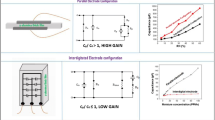Abstract
The effect of pore size and uniformity on the humidity response of nanoporous alumina, formed on aluminum thick films through an anodization process, is reported. Pore sizes examined range from approximately 13 to 45 nm, with a pore size standard deviations ranging from 2.6 to 7.8 nm. The response of the material to humidity is a strong function of pore size and operating frequency. At 5 kHz an alumina sensor with an average pore size of 13.6 nm (standard deviation 2.6 nm) exhibits a well-behaved change in impedance magnitude of 103 over 20% to 90% relative humidity. Increasing pore size decreases the humidity range over which the sensors have high sensitivity and shifts the operating range to higher humidity values. Cole–Cole plots of 5 to 13 MHz measured impedance spectra, modeled using equivalent circuits, are used to resolve the effects of water adsorption and ion migration within the adsorbed water layer. The presence of impurity ions within the highly ordered nano-dimensional pores, accumulated during the anodization process, appear highly beneficial for obtaining a substantial variation in measured impedance over a wide range of humidity values.
Similar content being viewed by others
References
B.M. Kulwicki, J. Am. Ceram. Soc., 74, 697 (1991).
H. Arai and T. Seiyama, in Sensors: A Comprehensive Survey, edited by W. Gopel, J. Hesse, and J.N. Zemel (VCH, Weinheim, Germany, 1992), Vol. 3, pp. 981–1012.
E. Traversa, Sens. Actuators B 23, 135 (1995).
N. Yamazoe and Y. Shimizu, Sens. Actuators 10, 379 (1986).
A. Bearzotti, I. Fratoddi, L. Palummo, S. Petrocco, A. Furlani, C. Lo Sterzo, and M.V. Russo. Sens. Actuators B 76, 316 (2001).
Y. Sakai, Y. Sadaoka, and M. Matsuguchi, Sens. Actuators B 35, 85 (1996).
C.A. Grimes and D. Kouzoudis, Sens. Actuators A 84, 205 (2000).
K.G. Ong, C.A. Grimes, C.L. Robbins, R.S. Singh, Sens. Actuators A 93, 33 (2001).
T. Seiyama, N. Yamazoe, and H. Arai, Sens. Actuators 4, 85 (1983).
L. Ketron, Ceram. Bull. 68, 860 (1989).
E. Traversa, G. Gusmano, and A. Montenero, Eur. J. Solid State Inorg. Chem. 32, 719 (1995).
M.K. Jain, M.C. Bhatnagar, and G.L. Sharma, Sens. Actuators B 55, 180 (1999).
O.K. Varghese and L.K. Malhotra, J. Appl. Phys. 87, 7457 (2000).
G. Sberveglieri, R. Murri, and N. Pinto, Sens. Actuators B 23, 177 (1995).
E. Traversa, M. Baroncini, E.D. Bartolomeo, G. Gusmano, P. Innocenzi, A. Martucci, and A. Bearzotti, J. Eur. Ceram. Soc. 19, 753 (1999).
K-S. Chou, T-K. Lee, and F-J. Liu, Sens. Actuators B 56, 106 (1999).
E. Traversa, G. Gnappi, A. Montenero, and G. Gusmano, Sens. Actuators B 31, 59 (1996).
Y-C. Yeh, T-Y. Tseng, and D-A. Chang, J. Am. Ceram. Soc. 72, 1472 (1989).
E. Traversa, J. Am. Ceram. Soc. 78, 2625 (1995).
T. Yamamoto and K. Murukami, in Chemical Sensor Technology, edited by T. Seiyama (Kodansha and Elsevier, Amsterdam, The Netherlands, 1989), Vol. 2, pp. 133–149.
F. Ansbacher and A.C. Jason, Nature 171, 177 (1953).
V.K. Khanna and R.K. Nahar, Sens. Actuators 5, 187 (1984).
S. Basu, S. Chatterjee, M. Saha, S. Bhandyopadhay, K.K. Mistry, and K. Sengupta, Sens. Actuators B 79, 182 (2001).
G. Sberveglieri, R. Anchisini, R. Murri, C. Ercoli, and N. Pinto, Sens. Actuators B 32, 1 (1996).
L.H. Mai, P.T.M. Hoa, N.T. Binh, N.T.T. Ha, and D.K. An, Sens. Actuators B 66, 63 (2000).
S. Chatterjee, S. Basu, S. Bandyopadhay, K.K. Mistry, and K. Sengupta, Rev. Sci. Inst. 72, 2792 (2001).
R.K. Nahar, Sens. Actuators B 63, 49 (2000).
Z. Chen, M-C. Jin, and C. Zhen, Sens. Actuators 2, 167 (1990).
S. Basu, M. Saha, S. Chatterjee, K.K. Mistry, S. Bandyopadhay, and K. Sengupta, Mater. Lett. 49, 29 (2001).
Y. Sadaoka, Y. Sakai, and S. Matsumoto, J. Mater. Sci. 21, 1269 (1986).
Chemical Sensors, edited by T. Seiyama, K. Fueki, J. Shiokawa, and S. Suzuki (Elsevier, New York, 1983).
Y. Shimisu, H. Arai, and T. Seiyama, Sens. Actuators 7, 11 (1985).
S.H. Tao, W.M. Tang, L. Ping, and Y. Xi, Sens. Actuators 19, 61 (1989).
H. Masuda and K. Fukuda, Science, 268, 1466 (1995).
H. Masuda, F. Hasegwa, and S. Ono, J. Electrochem. Soc. 144, L127 (1997).
O. Jessensky, F. Muller, and U. Gosele, Appl. Phys. Lett. 72, 1173 (1998).
J.R. Macdonald, Impedance spectroscopy (John Wiley, New York, 1987).
http://www.tesatape.com
http://www.solartronanalytical.com/downloads/downloads.html
A.E. Falk, B.M. Lacquet and P.L. Swart, Electron. Lett. 28, 166 (1992).
A.K. Jonscher, J. Mater. Sci. 13, 553 (1978).
A.K. Jonscher, Phys. Status Solidi A 32, 665 (1975).
W.J. FLeming, SAE Trans., Sec. 2 90, 1656 (1981).
V.K. Khanna and R.K. Nahar, Appl. Surf. Sci. 28, 247 (1987).
V.K. Kanna and R.K. Nahar, J. Phys. D: Appl. Phys. 19, L141 (1986).
R.K. Nahar, V.K. Khanna, and W.S. Khokle, J. Phys. D: Appl. Phys. 17, 2087 (1984).
R.K. Nahar and V.K. Khanna, Sens. Actuators B 46, 35 (1998).
G.C. Wood, P. Skeldon, G.E. Thompson, and K. Shimizu, J. Elec-trochem. Soc. 143, 74 (1996).
G. Patermarakis and K. Moussoutzanis, J. Electrochem. Soc. 142, 737 (1995).
Author information
Authors and Affiliations
Rights and permissions
About this article
Cite this article
Varghese, O.K., Gong, D., Paulose, M. et al. Highly Ordered Nanoporous Alumina Films: Effect of Pore Size and Uniformity on Sensing Performance. Journal of Materials Research 17, 1162–1171 (2002). https://doi.org/10.1557/JMR.2002.0172
Received:
Accepted:
Published:
Issue Date:
DOI: https://doi.org/10.1557/JMR.2002.0172




